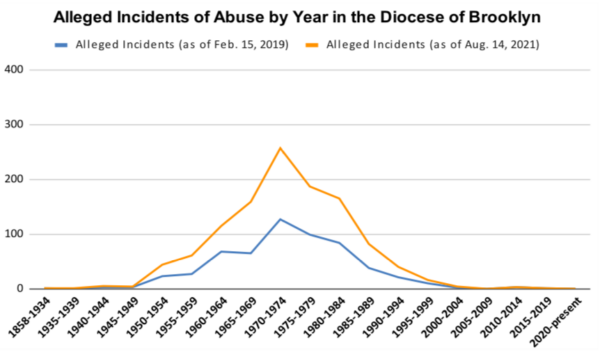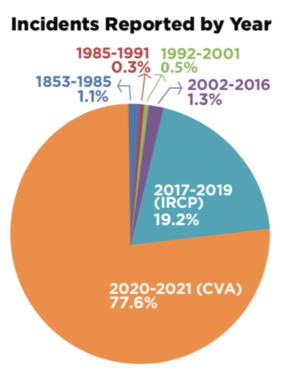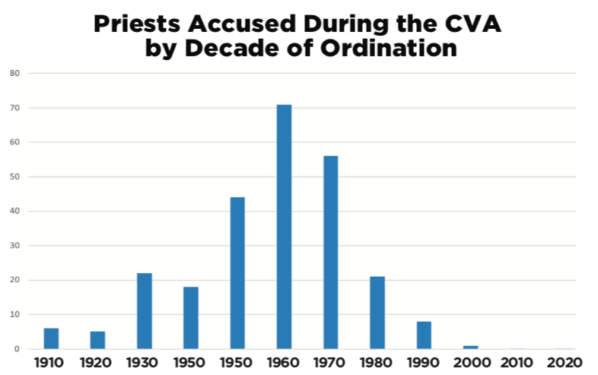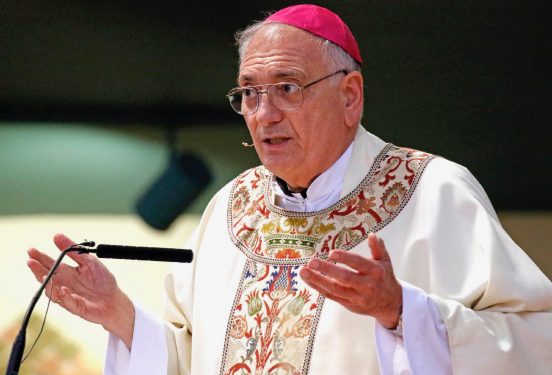
My dear brothers and sisters in the Lord,
The abuse of children anywhere is a heinous crime and sin. When it occurs by those working in the Catholic Church, however, the abuse is even more horrific. This should never have happened. The problem of sexual abuse is a societal problem that permeates the Church, schools, sports programs and families. “Child sexual abuse is likely the most prevalent health problem children face with the most serious array of consequences,” according to Darkness to Light, a non-profit that works to prevent childhood sexual abuse.
“Since the 1990’s we have seen almost a 50% decline in the occurrence of childhood abuse,” the group cites. We have experienced that in our Diocese in Brooklyn and Queens. Since 2002, when clear reporting guidelines were established by the United States Conference of Catholic Bishops, known as the Dallas Charter, we have had six credible allegations of sexual abuse. While numbers are thankfully declining, even one is too many. We, the Church, cannot ignore our history.
When abuse happens at the hands of a priest, it is a betrayal. While an apology could never be enough, I am wholeheartedly sorry for the crimes committed against our children by those who represented the Church. During my time as your Bishop for the last 18 years, and with the recent conclusion of the Child Victims Act (CVA) two-year look back period enacted in the State of New York, we have learned of many new allegations against priests, religious and laity who ministered in Brooklyn and Queens. That is why I feel it is important to give you some kind of an accounting regarding the lawsuits filed against the Diocese of Brooklyn under the Child Victims Act. I will try to present the situation in the most transparent way as possible.
TIMELINE
I can say that there were times where cases were not addressed properly when they came to the attention of the Diocese. What is unfortunate is that the Church has been blamed for covering up or failing to address all the cases brought against it properly. And this is just not accurate. Since 2002, all past and present cases known to the Diocese of Brooklyn were reported to the corresponding district attorney’s office. And a mechanism was established within the Diocese of Brooklyn to properly handle any allegation of sexual misconduct against a minor.
When you study the graphs presented you will see that most of the alleged abuse was never made known to the Church until 2002 or later. When the Diocese began the Independent Reconciliation Compensation Program, (IRCP) in 2017, and when the CVA look-back legislation was enacted, most of these cases were almost entirely unknown to the Church in Brooklyn and Queens. It would be impossible to cover up what we did not know.
Graph 1 (above) shows that in the overwhelming majority of cases, the alleged abuse occurred in the 1950s, 1960s, 1970s, and 1980s, a period of time that was substantially different than today. The number of cases declined after 1992, which reflects the trend that was happening in society as a whole. It is important to note, though, that in 1992, the United States Bishops issued the first guidelines for handling such cases and also how to best work with victims.
As you can see in the graph above, there was a beginning and an end to this, what has been called an epidemic. Its high point occurred in the 1970s and tapered off around the year 2000. This is shown by the blue and orange lines in the graph; the blue are the cases known to us prior to 2019, when we released the List of Credibly Accused Priests, and the orange represents the cases known to the Diocese as of August 2021 at the close of the CVA window.
In graph 2 (above) we see the reporting of these incidents began after 1985 and increased in 2002, when the Dallas Charter was promulgated. However, reporting largely began in 2017 when the IRCP was established and then overwhelmingly increased with the opening of the CVA.
The majority of the alleged abuse was unknown and never reported to the Church. There are many reasons for this lack of reporting. Shame, guilt, self-blame, and fear that no one will believe them are just a few reasons. The enormity of disclosing abuse perpetrated by a trusted person could dissuade anyone, but especially a child. Society back then was not open to listening to the issue of sex abuse. While it is also a fact that there is a lag in reporting of childhood sexual abuse, that for some could be decades long, I can assure you that since I have been here as Bishop in Brooklyn, the Diocese took seriously all those cases that were presented.
When I arrived in the Diocese of Brooklyn in October of 2003, I immediately established an external Toll-Free Reporting Line — 1-888-634-4499 — so that no one in the Diocesan administration would deal in any way with a case until it had been properly reported by an attorney, unaffiliated with the Diocese of Brooklyn, who then forwarded the case to the appropriate district attorney.
An allegation is defined as an accusation made by a person in a legal setting which then needs to be proven through an investigation. It does not mean that an actual act of sexual abuse took place. I give the example of my own situation where two allegations were made against me in the Archdiocese of Newark. After a thorough investigation by the firm of a former F.B.I. Director and a former Federal Prosecutor, the Holy See reviewed the findings and issued a statement saying that “there was no semblance of truth” to these allegations.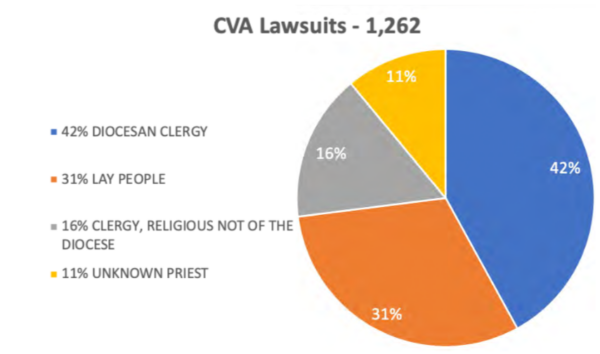
As of the analysis done to date, we have received more than 1200 CVA lawsuits against the Diocese of Brooklyn. 42% of these claims involve diocesan clergy, 31% involve lay teachers, volunteers, boy scout leaders, coaches, and employees, 16% involve religious and clergy not of our diocese and 11% of all of the cases identify the perpetrator as a priest, however, do not identify the priest by name. Some are identified as Fr. Perpetrator or Fr. John Doe.
If we are talking just about priests, 18% of all CVA cases against diocesan, religious and extern priests have no name identified. This presents a difficulty in trying to figure out if these cases are legitimate. But I can assure you that no accusation is left uninvestigated by the independent Diocesan Review Board (DRB). And if the DRB, which is made up of lay professionals with expertise in family law, sex offenders, law enforcement and mental health, determines a case against a member of the clergy is credible, the perpetrator will be removed from ministry. Our No Tolerance policy means no one with a credible accusation of misconduct against a minor gets a second chance. One other statistic of notable importance — more than half of the diocesan priests accused had no prior accusation.
PREVENTION
All adults who minister and work for the Diocese of Brooklyn must undergo the VIRTUS program training. This includes bishops, priests, deacons, religious brothers and sisters, lay employees and all volunteers, which consists of parents, coaches, lectors, teachers, eucharistic ministers, youth ministers and more. In other words, the body of the Church must take the VIRTUS training. This is an interactive training that instructs adults in the Church on how to protect children through continuous awareness and vigilance. The training teaches participants to recognize signs of child sexual abuse, and the methods and means by which offenders commit abuse.
The guidelines today are to report abuse immediately, or even when they may see red flags such as boundary violations occurring. Additionally, all who come forward are also encouraged to exercise their right of reporting to the legal authorities. Studies show sexual abuse is prevented at higher rates when the community as a whole is involved in making environments safer for children.
Sexual abuse awareness training is also provided at an early age for the children in our Catholic schools and academies, as well as our religious educations programs. The Child Lures program teaches children to be aware of their “internal signals” that go off when someone is crossing boundaries and provides them with age appropriate language to assist them in disclosing to an identified trusted adult.
Additionally, the Diocese conducts background checks of all clergy, religious and lay employees at the start of employment or service and continues to do them quarterly, to ensure that if something happens, for instance an arrest over the weekend, we are notified immediately.
No system is a perfect one, as it relies on human beings seeing something and saying something. I have spent a significant amount of time in my episcopacy instituting these precautions to protect children. We will never be able to say that with all of the above protections in place that sexual abuse will never happen again. But what we can say is that we as a Church, the community of parents, teachers, volunteers, and clergy are working together to extinguish this problem. This work will never end. Protecting our children is our most important mission.
We have made tremendous strides with education, and, thus, we witness an easing and reducing of the fear to speak out against sexual abuse and reporting any such abuse to the proper authorities. The Toll-Free Reporting Line is publicized in a poster that is placed in each and every Church in Brooklyn and Queens, as well as on the inside cover of our diocesan newspaper, The Tablet, each week. All the prevention measures and protective factors mentioned above are contributing to a safer Church, far different than it was 50, 60 and 70 years ago.
VICTIM ASSISTANCE
In addition to the ministry to protect our children, we have remained committed to providing for the Victims of Sexual Abuse. In 2014, working in coordination with a focus group of survivors in our diocese, I started our annual Mass of Hope and Healing. As a diocese, we came together and prayed for victims of clergy sexual abuse. This focus group later became known as our Survivors Advisory Board, since the input of survivors themselves is so valuable. Our Office of Victim Assistance Ministry provides supportive initial counseling, referrals for therapy and pastoral resources.
Each year, we offer new and varying support groups for survivors. I hope and pray that there will be a day when sexual abuse is eradicated from our society and especially in our Church. I am confident that the measures we have in place are making a difference in protecting our youth and young adults from sexual abuse.
As I mentioned before, we have attempted to reconcile and compensate victims of abuse through our Independent Reconciliation Compensation Program (IRCP). This program was headed by Kenneth Feinberg, an attorney specializing in mediation, who headed the compensation for the September 11th Victim Compensation Fund. For the diocese, he evaluated any cases of alleged abuse that were made and scaled them based on the severity of the abuse. There were 512 people whose cases were brought through the IRCP. It is unfortunate that the New York State Child Victims Protection Act does not allow for independent evaluation of alleged abuse.
The diocese has entered into a litigation process which will be time consuming. These individuals who have made allegations, unfortunately, will wait a long time for resolution, given the nature of litigation. In the IRCP, victims do not need a lawyer, however, they could be represented by a lawyer. With the CVA cases, however, lawyers require at least 1/3 of the compensation as their fee. The situation has resulted in bankruptcy for four dioceses in the State of New York. It is my belief, as your Bishop, that the Diocese of Brooklyn will be able to give just compensation to the victims. I ask for your patience as we investigate these cases and ensure we will do our best to respect legitimate victims of abuse.
In the final graph (above), labeled “Priests Accused During the CVA Process by Decade of Ordination” you can see that the number of priests who have been accused by ordination years have decreased dramatically. Our younger seminarians and priests have undergone training in human sexuality, so that they are aware of any personal tendencies that might lead them to abuse another person. Their training goes beyond the Virtus program.
For example, seminarians take part in workshops with social workers and mental health professionals on identifying patterns of sexual abuse and how the trauma of sex abuse is treated clinically and spiritually. There are workshops on celibacy, maintaining professional boundaries in ministerial settings and the proper use of social media.
After having gone thru the IRCP and the CVA, in order to strengthen the work of the Diocese with respect to these issues, a reorganization has been implemented. Jasmine Salazar, LMSW, currently our Victim Assistance Coordinator and Vice Chancellor, will now take on the position of Director of the newly established Office of Protection of Children and Young People. The office will coordinate the work of the Office of Safe Environment and the Victim Assistance Coordinator, among other responsibilities. This move will solidify our ability to continue to provide safe environments for the faithful of the Diocese of Brooklyn.
As we put out into the deep of waters of reconciliation and compensation, please join me in praying especially for the victims of sexual abuse at the hands of those who work for the Church. There is no amount of compensation that can make up for the crimes against them. Only God’s mercy can reconcile them.

